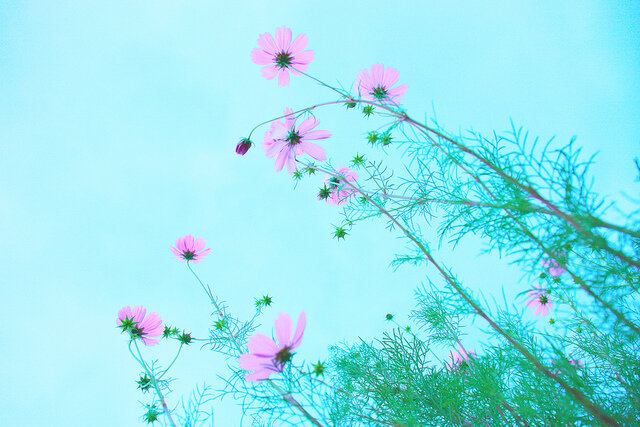"Natural" Co-Wash & Leave-In Conditioners
I've been testing a few natural conditioners that work well with a no-poo hair regimen, co-washing, and specifically the Curly Girl Method. One thing that I did learn during this process is that the ingredients that make a conditioner different from a moisturizing lotion is that conditioners contain fatty alcohols, quaternary ammonium salts, and hydrolyzed vegetable proteins. All of these ingredients are chemically derived one way or another. I honestly feel more comfortable with fatty alcohols and hydrolyzed vegetable proteins than quaternary ammonium salts.
Fatty Alcohols
"Fatty alcohols are oleochemicals derived from vegetable feedstocks (which) include coconut and palm kernel oils. These refined vegetable oils are first converted to a methyl ester or fatty acid. This reaction generates crude glycerine. The intermediate methyl ester or fatty acid are then fractionated and hydrogenated to produce fatty alcohol. Alcohols are often distilled and fractionated to achieve the chain length distribution." ~P&G Chemicals
A few examples of fatty alcohols as listed in conditioner ingredients are coconut fatty acid base (a mislabeled term), cetyl alcohol, stearyl alcohol, and cetearyl alcohol. Fatty alcohols add detangling properties to conditioners and also some create foaming properties to the product.
Quaternary Ammonium Salts
For those who love science here is a medical journal titled "The Differential Toxicity of Ammonium Salts”. From the research that I’ve done, it seems as if certain quaternary ammonium salts are toxic while others are not considered toxic at all. Two ammonium salt ingredients to avoid are PEG's and benzalkonium chloride. A few examples of quaternary ammonium salts that are used in conditioners are behentrimonium chloride, behentrimonium methosulfate, stearalkonium chloride, and cetrimonium chloride. These ingredients act as mild preservatives as well as add serious detangling and conditioning to the hair.
Hydrolyzed Vegetable Proteins
Hydrolyzed vegetable proteins are common in so many conditioners. A few that I see a lot are wheat protein, soy protein, and rice protein. When I looked them up in the Cosmetic Database, wheat protein and soy protein were rated a "0" in toxicity while rice protein was rated a "2". I’m not as concerned with hydrolyzed vegetable proteins in conditioners yet they are still chemically derived.
Chemicals and Itchy Skin
So after all of this ingredient talk you are probably wondering which conditioners that I tested and liked. I’ll admit it’s been frustrating finding a conditioner that would abide by my specific requirements and serve as a multi-use conditioner. You may also want to know that I specifically have been searching for conditioners that didn’t contain phenoxyethanol which is a preservative that can also contribute to skin irritations. I usually have itchy skin when I use products with certain chemicals or preservatives.
The Conditioners Tested
Trader Joe's Tea Tree Tingle Conditioner
Ingredients: purified water with *tea tree, *peppermint oil, *eucalyptus oil, *nettle oil, *thyme oil, birch leaf oil, *chamomile oil, *clary, *coltsfoot leaf, *yarrow oil, *mallow, *horsetail oil, *soybean protein, cetyl alcohol, tocopherol vitamin e, trace minerals, citric acid, sodium hydroxymethylgycinate, grapefruit seed.*organic ingredients
I've used the Trader Joe's Tea Tree Tingle Conditioner before. It definitely gives the scalp a tingling sensation yet not too much. I really like this product as a co-wash conditioner, yet not as a leave-in simply because my skin doesn’t like all of the ingredients. Also sodium hydroxymethylgycinate is a preservative that can also be a skin irritant with possible formaldehyde contamination. I'm not happy with this ingredient, yet this is a very affordable co-wash conditioner.
Shea Moisture Raw Shea Butter Restorative Conditioner
Ingredients: Deionized Water, Butyrospermum Parkii (Shea Butter)*, Argan Oil, Coconut Oil*, Behentrimonium Chloride, Essential Oil Blend, Vegetable Glycerin, Emulsifying Wax, Sea Kelp Extract, Panthenol (Vitamin B‐5), Avocado Oil, Lonicera Caprifolium (Honeysuckle) Flower (and) Lonicera Japonica (Japanese Honeysuckle) Flower extract, Tocopherol (Vitamin E), Daucus Carota Sativa (Carrot) Seed Oil.
All in all I found the Shea Moisture Raw Shea Butter Restorative Conditioner to be very very moisturizing, easy to detangle my hair with, a wonderful leave-in, and smells like sweet honeysuckle. This conditioner does not give hair hold yet defined my curls. It made my hair extremely soft. I currently co-wash my hair every 2-3 days. To refresh frizzy third day hair I simply add flax seed gel to dry hair in sections and my hair looks like day one all over again.
Earthly Delight Hair Conditioner
Ingredients: Deionized water, vegetable glycerine, rice bran oil, avocado oil, wheat germ protein, panthenol, amino acids, vegetable emulsifying wax, essential oils of neroli, cinnamon & coconut.
One of my concerns with leaving this conditioner in my hair was that it contained wheat germ protein. I’ve experienced hard dry hair with conditioners that had proteins in them. I wasn't sure how this conditioner would work out. To my surprise Earthly Delight Hair Conditioner was amazing for detangling my curly hair, left my hair extremely soft as a leave-in, and also turned out to be a fantastic deep conditioner. For defined curls, I suggest using this conditioner with flaxseed gel or another natural gel.
In terms of ingredients I’m extremely content with this conditioner. It also has a spicy herbal smell which I love. I haven’t experienced any build-up with this conditioner, yet there’s always my DIY Green Tea Cleansing Hair Rinse to use as needed.
Test More Conditioners or Make My Own
I plan to try maybe one or two more conditioners if I can find what I’m looking for. To be honest I will probably end up going back to making my own conditioner again. It will also be better in terms of not having to purchase one more thing in a plastic container that is not in bulk. Also I do have a few new ideas since I have done more research so I'm up to the challenge.
What's your favorite natural conditioner?
Image by D Sharon Pruitt

